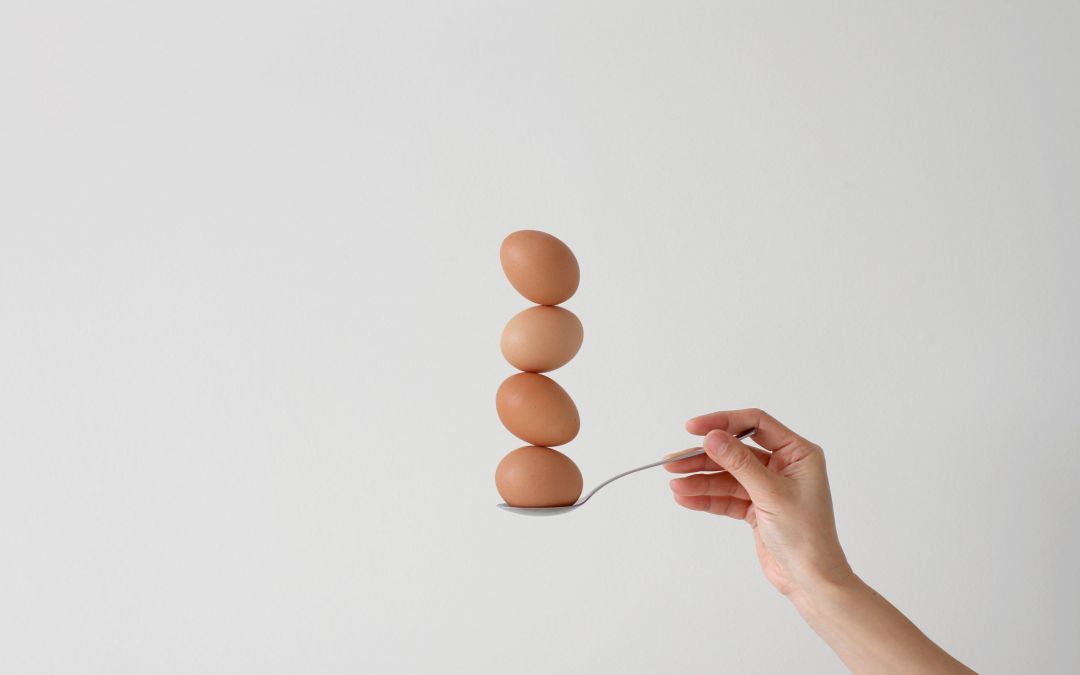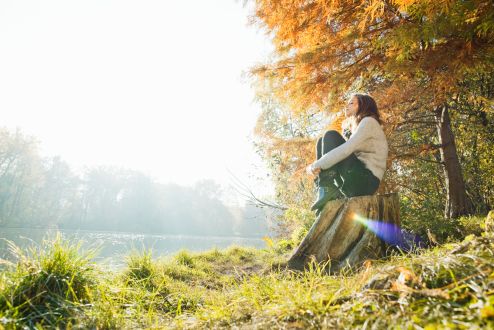Stop doing, start being: how to reset and rebalance your life
Is your life bulging at the seams with doing and not enough being? Are you constantly acting and planning, bereft of stopping, resting and relaxing? Do you give, give, give and find it hard to receive? Anita Chaudhuri discovers if it’s possible to find a happier balance

9 minute read
So, how is your year unfolding? Are you still powering through the lofty, shiny goals you set in January? I find myself pondering this question for an interesting reason. For the first time I can remember, I have actually stuck to the plan. I’m ticking off my to-do lists, achieving mini targets and making solid, measurable progress in many different areas of my life.
Amazing, right? Admittedly, I do feel happy about it. Well, sort of. Actually, if I’m being really honest, I am exhausted… Not to mention harried, with a side order of snappiness, impatience and irritation. Hang on, this isn’t what I cosmicordered! What’s going on? Slowly, it dawns on me that I have barely given myself time to breathe. My focus has been so intense, my activity levels so feverish, I’ve forgotten why I wanted to do any of it in the first place. In short, I feel profoundly out of balance.
A horizontal see-saw
Peter Borten has a doctorate in traditional Chinese medicine (TCM) and is co-author of The Well Life (Simon & Schuster, £10.99). He suggests that in order to experience true wellness, we need to understand the concept of dynamic balance. ‘In TCM, this balance is usually expressed as the two-part harmony of yin and yang. And, in Ayurveda, it’s often expressed as the balance of three qualities known as sattva, rajas and tamas. Because of the constant push and pull between the elements of an organic system, it’s unrealistic to expect ourselves to maintain a state of constant, perfect balance. However, the more conscious we become of how we’re affected by diverse variables such as our thinking, our eating and our climate, the more readily we can make adjustments in order to bring ourselves back to centre. In this way, we can achieve a dynamic balance that works for us.’
Natural forces
Borten is married to a practitioner of Ayurveda, Briana Borten, and together they run the Dragontree Apothecary in Portland, Oregon. He references the poetic Daoist texts of ancient China – Zhuang Zi and Lao Zi (the Dao De Jing or Tao Te Ching) – written a few centuries BCE by sages who spent most of their lives observing and contemplating nature. ‘These books aim not so much to discuss the subtle and majestic dynamics of the natural world, but to illustrate how these dynamics exist in human psychology, behaviour, politics, business and relationships,’ he says. ‘Besides noticing all the many things that happen in nature, they notice something unseen, yet ever present, which they call Dao: the natural order of the world – the force and character that emanate and unite all the different expressions, and the manner in which natural phenomena occur – this is Dao. Sort of…’
Have you seen my yin?
Seeking more practical answers, I consult Clare Russell, a coach specialising in mentoring women at key points of transition in their lives. She works with everyone from those looking for a different way of doing things in relationships, health or work, to women in leadership roles in business and politics. One of her specialisms is addressing an issue she defines as a ‘yin deficiency’.
‘To put yin and yang into context: it is the idea that whether you are a woman or a man, we all have aspects of yin – the feminine – and yang – the masculine – within us. We need both to work together to be healthy and thriving. But from culture, education and society, we are encouraged to live from our yang. This manifests as being busy all the time and forever focused on the next thing to do.’
When she puts it like that, I can see that I have definitely been spending too much time on Planet Yang. ‘When you have a yin deficiency, it’s really hard to stop and, if you do, you feel anxiety or guilt. You become a slave to the to-do list and you feel a disconnection from your body, your senses and your emotions. Very often, you will rely on caffeine to keep you going, rather than seeking out what you really need – a hug from a friend or something else that is more feelings-based; more relationship-based.’
Homo machina
Something that is guaranteed to knock us off balance is when we become overly mission-focused in life. ‘It’s the myth of productivity – the idea that your value is directly related to your output,’ explains Russell. ‘It’s a machine way of viewing ourselves which excludes imperfection and stopping for a rest. It also excludes something we need in order to be creative – space for the unknown. Yes, you are probably more productive if you keep doing the same thing again and again – but it becomes increasingly less fulfilling. It requires all this chaotic, different, exciting, but at the same time unnerving, space around it.’
However, it’s important to grasp that yang is not a bad thing. ‘Yang is where you’re passionate about achieving something and you tell yourself “I’m going to go for it!” You become laser-focused. The yin is the space for holding it all; the out breath versus the in breath, it’s our ability to look up from that goal and see what’s all around us. Yin has a reflective quality. In the yin, you ask: “How am I feeling today?” We are encouraged to focus on the material, physical world, rather than the intuitive, sensing world,’ she says.
Identify those dragons
How might we begin to harness these polarities and try to make them work in our favour? Tamara Russell is a clinical psychologist, martial artist and neuroscientist. She believes that instead of focusing on the either-or dichotomy of masculine and feminine, we can view the brain as having three different modes.
‘I run workshops called “What colour is your dragon?”,’ she explains. ‘There’s red dragon, who you should learn to love, but he gets so big with his fire that he starts to burn everything around him, including himself.’ This creature is typically conjured when you’re experiencing a sense of threat. ‘For women, we are approaching a moment in society when we need to summon the red dragon. We’re standing up and getting angry, saying “this is not OK”.’ The blue dragon, meanwhile, has the superpower of flight. He likes to flap his wings, but he flaps too much and gets burned out and needs to rest and restore himself.’ Blue dragon is classic yang. ‘Lastly, there is the green dragon. Green is the creative and nurturing dragon.’
Dr Russell suggests an exercise where you look at your daily schedule, armed with blue, red and green pencils. ‘Mark off when you were in a green, red or blue zone. For example, commuting would likely be red, as would a difficult meeting, getting shouted at by a client or dealing with quarrelsome kids at home. Organisations think that people arrive at work and are productive “blue” all day. So, when I do the exercise at corporate workshops, people are surprised. You need to create pockets of green in your day.’
But finding the green in your day needn’t involve a major effort: ‘Opt for sky time, rather than screen time,” advises Dr Russell. When you walk to the train station, don’t look at your phone. Instead, look up. Make eye contact with the people you pass. Let someone go ahead of you at the ticket barrier or in the supermarket queue,’ she suggests. She uses her martial arts training to illustrate the point. ‘In tai chi, we call this “yielding”. The masculine wants to attack – the yin says “come to me (but then I’ll invade you)”. If you meet force with yielding, however, no one can beat it. The softness is the strength. If someone yields to your attack, your force will be used against you and you’ll go flying under your own power.’
Even once we’re aware of these opposing energies, we don’t always understand the best way to integrate them and rebalance ourselves. ‘When people get home from work, they often resort to what I term “fake green” activities, such as bingeing on Netflix, having a few glasses of wine or vegging out on the sofa looking at mind-numbing things on YouTube.’ She’s basically describing my downtime. ‘The idea is to nurture more intentional “green” activities, with the aim of self-care and creating mental space. You want to fill up the tank.’
Inner joy sucker
The trouble is, I don’t even begin to know how to do that. I return to Clare Russell for one-to-one coaching at Evolve, a yoga space in London. I’m not sure what to expect. Can you really be coached to access your yin side, something I’ve come to associate with the shadow of the psyche? What if I conjure up the spirit of Elvis? What if the door to this magic portal is nailed shut?
Before my session, I received a worksheet of questions designed to pinpoint where I am in life. We begin by discussing the issues raised. I’m not sure how to explain, but I often feel as if I’m in a tug of war between my rational and creative selves. It is this, I fear, that saps the pleasure out of my creative projects. However big and bright my ideas might be, there’s a voice pushing me to only explore things for which I believe there’s a ‘market’. This voice is rational, sceptical and occasionally mean: ‘That’s a stupid idea; imagine what people will think!’
Russell leads me into a space of meditative reflection, beginning with breathing into my ‘womb space’. We spend some time here where I am to pay attention to what I feel and hear. From there, we move up to the ‘heart space’ and the process of mindful listening is repeated. Finally, we repeat the exercise by visiting the ‘mind space’. The experience is extraordinary. My visualisations are teeming with colour, abundance and aliveness – until we get to the mind space. A green-grey mist descends and I feel constricted and miserable.
Russell finds this fascinating. ‘It’s not that you are cut off from your yin – your yin is thriving – it’s just that your mind has got it on lockdown.’ Rather than viewing the rational, logical self as ‘bad’, however, Russell suggests that a gentler ‘yin’ way forward is inclusion. ‘Thank this part of you for its contribution but allow other aspects of yourself to be heard as well,’ she says.
Prepare for your heroine
Russell has studied The Heroine’s Journey by Jungian psychologist Maureen Murdock (Shambhala Publications, £15.99) as an alternative to Joseph Campbell’s The Hero’s Journey (New World Library, £16.99). ‘Women are on a journey of transformation that looks a bit different. We are taking a journey but, instead of fighting demons and slaying dragons, we are tooling up to go into our unconscious where we will find all the juicy stuff – our wildness, our passion and our embodied, sensual self. If you want to access that, you have to meet it in a different way.’
I ponder this. Maybe there’s part of me that I have yet to discover that is key to my creativity. It strikes me that most of my visualisations feature imagery from nature: trees, flowers, sky, birds and giant bees. An obvious place to continue my yin journey is to make a commitment to spend more time in nature.
It’s an idea that is deeply rooted in ancient philosophy. As Borten says: ‘One of the lines from the Dao De Jing that struck me is: “In pursuit of knowledge, every day something is added. In the practice of the Dao, every day something is dropped.” If you spend enough time in nature, you get a sense of how things move and change; rhythm and balance. What the Daoists were essentially saying is that the more we allow affairs in the human realm to operate by the same rhythm and balance, the happier and healthier we will be. Only humans try to make life unfold faster than its natural pace. Only humans seek to muscle their way to a destination we would have arrived at effortlessly. When do we act? When it’s time to act. When do we rest? When it’s time to rest. How do we know? By tuning in.’
Armed with that advice, I give myself permission to take a daily walk, armed with a sketchbook. I live and work in an urban environment, so it takes 20 minutes to reach anything approaching ‘nature’. At first, that makes me grumpy and I focus on what I don’t have. But I rapidly begin to enjoy my walks, and then to anticipate them. I start sketching birds, trees and flowers. These are wonky and haphazard but, when I return to my busy day, I’m calmer and more creative than I’ve been in months. And Elvis hasn’t shown up once.
Image: Getty









